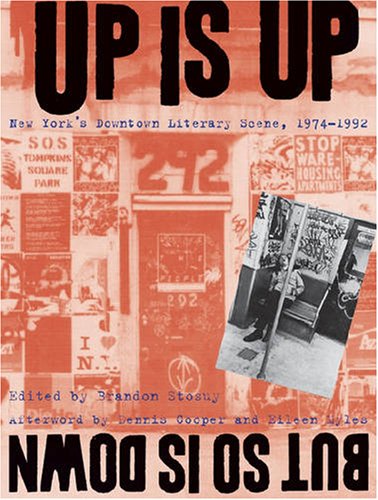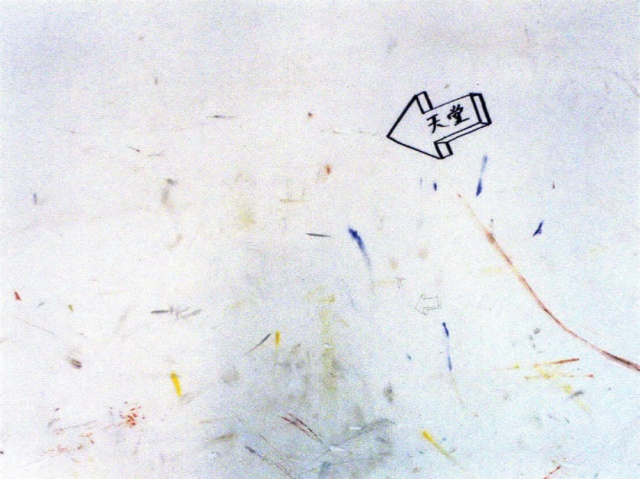Brandon Stosuy (ed.): Up Is Up, But So Is Down: New York’s Downtown Literary Scene, 1974-1992 (2006)
Filed under book | Tags: · 1970s, 1980s, 1990s, art, diy, history of literature, literature, music, new york, poetry, publishing, theatre

“Sometime after Andy Warhol’s heyday but before Soho became a tourist trap, a group of poets, punk rockers, guerilla journalists, graffiti artists, writers, and activists transformed lower Manhattan into an artistic scene so diverse it became known simply as “Downtown.“ Willfully unpolished and subversively intelligent, figures such as Spalding Gray, Kathy Acker, Richard Hell, David Wojnarowicz, Lynne Tillman, Miguel Piñero, and Eric Bogosian broke free from mainstream publishing to produce a flood of fiction, poetry, experimental theater, art, and music that breathed the life of the street.
The first book to capture the spontaneity of the Downtown literary scene, Up Is Up, But So Is Down collects more than 125 images and over 80 texts that encompass the most vital work produced between 1974 and 1992. Reflecting the unconventional genres that marked this period, the book includes flyers, zines, newsprint weeklies, book covers, and photographs of people and the city, many of them here made available to readers outside the scene for the first time. The book’s striking and quirky design—complete with 2-color interior—brings each of these unique documents and images to life.
Brandon Stosuy arranges this hugely varied material chronologically to illustrate the dynamic views at play. He takes us from poetry readings in Alphabet City to happenings at Darinka, a Lower East Side apartment and performance space, to the St. Mark’s Bookshop, unofficial crossroads of the counterculture, where home-printed copies of the latest zines were sold in Ziploc bags. Often attacking the bourgeois irony epitomized by the New Yorker’s short fiction, Downtown writers played ebulliently with form and content, sex and language, producing work that depicted the underbelly of real life.
With an afterword by Downtown icons Dennis Cooper and Eileen Myles, Up Is Up, But So Is Down gathers almost twenty years of New York City’s smartest and most explosive—as well as hard to find—writing, providing an indispensable archive of one of the most exciting artistic scenes in U.S. history.”
With an afterword by Dennis Cooper and Eileen Myles
Publisher NYU Press, 2006
ISBN 9780814740118
500 pages
Downtown Collection at NYU’s Fales Library
Reviews: Ed Halter (Village Voice, 2006), Meghan O’Rourke (New York Times, 2006), Tim W. Brown (Columbia Journal of American Studies, n.d).
Commentary: Cynthia Carr (New York Times, 2006), Peter Cherches (2006).
PDF (39 MB, updated on 2019-8-23)
Comments (2)Winnie Won Yin Wong: After the Copy: Creativity, Originality and the Labor of Appropriation: Dafen Village, Shenzhen, China, 1989-2010 (2010)
Filed under thesis | Tags: · 1990s, 2000s, appropriation, art, authorship, china, conceptual art, contemporary art, creativity, labour, painting

“Since 1989, Dafen village in Shenzhen, China, has supplied millions of hand-painted oil-on-canvas paintings each year to global consumer markets. Accused of copying Western masterpieces, and spurred by the Chinese party-state’s creative industry policies, Dafen village’s eight thousand painters have been striving to become original artists. Simultaneously, conceptualist artists from outside Dafen village have engaged with the creative alienation of Dafen painters, by purchasing their labor in works of appropriation art. This study examines the discourses of creativity, originality, and appropriation that frame Dafen’s painting production, and sets them against an ethnography of flexible work in the South Chinese painting trade. It explores the myriad ways in which Dafen village lends itself to intellectual and aesthetic explorations of the separation of painting labor from conceptual labor, as enacted in both modernist and postmodernist framings of artistic authorship.
The study begins by charting the historical categorization of Chinese ‘export painting’ and the emergence of the ‘painting factory’ as a cultural imaginary of Sino-Western trade. It then examines the political stakes of ‘creativity’ as constructed in Dafen television propaganda made by the national and local party-state. Then, turning to a single Vincent van Gogh-specialty workshop and the transnational wholesale and retail of van Gogh trade paintings, it theorizes the relationship of ‘craft’ to modernist authorship and signature style. Finally, it scrutinizes cosmopolitan conceptual artists’ and designers’ collaborations with Dafen painters, exploring the ethical and aesthetic terms of universal creativity raised by the Dafen ‘readymade’. Establishing continuities between Dafen production and the making of ‘high’ art while challenging their putative antinomies, this study shows how the ideology of individual creativity undergirds the cultural industry policies of the local party-state, the consumer demand for authentic craft, and the appropriation of labor in contemporary art.” (Abstract)
Thesis, Ph. D. in History, Theory, and Criticism of Art and Architecture
Dept. of Architecture, Massachusetts Institute of Technology, 2010
Supervisor: Caroline A. Jones
410 pages
Karin Grace Oen: Admonition and the Academy: Installation, Video, and Performance Art in Reform Era China (2012)
Filed under thesis | Tags: · 1980s, 1990s, art, art history, china, installation art, performance art, video, video art

Wu Shanzhuan, The Big Characters, 1985. (source)
“China’s Reform Era (1978-present) has seen the reinvigoration of academic, and artistic practice, and a rapprochement between the Chinese Communist Party and the intellectual elite. At its beginnings in the early- to mid-1980s the new availability of foreign texts and media led to Culture Fever, a widespread phenomenon throughout the intellectual and artistic spheres characterized by enthusiasm for the philosophy, literature, and art of the West and pre-Communist China and the simultaneous uptake of discrete Western and Confucian philosophies. These discussions often addressed modernity and modernism in China, a crucial homology to early twentieth century Chinese negotiations in literature and the arts and the development of an amalgamated ‘Chinese modernism’ comprised of elements of both Confucian and Western philosophy and aesthetics.
As this dissertation argues, key early experimental works of the Reform Era by Zhang Peili, Wu Shanzhuan, and Zhang Huan reveal a proclivity for subtle and indirect admonitory messages about China’s socio-political climate – a contemporary inhabitation of the traditional elite scholar-artist and his obligation to criticize immoral or unjust policies or actions. This admonitory practice was built by artists educated in elite academies (specifically, the Central Academy of Fine Art in Beijing and the Zhejiang Academy of Fine Art in Hangzhou) yet utilized completely new and non-academic media. What this thesis terms as an ‘art of admonition’ utilized traditional tropes, including direct remonstrations of officials, withdrawal from official life in protest, and the concept of the ‘middle hermit’ – a scholar who admonishes official policy subtly and indirectly.
The experimental practices of artists after their graduation from elite academies stemmed from the extra-curricular resources made available to them, especially the schools’ libraries. The connection of these unofficial works to the official academies, their validation by art market success, and the subsequent official endorsement accorded to these and other artists in the later Reform Era blurs the distinctions between official and unofficial artistic practice in China, suggesting a strong endorsement of the dissident artist’s role as ‘middle hermit’.” (Abstract)
Thesis, Ph. D. in History, Theory, and Criticism of Art and Architecture
Dept. of Architecture, Massachusetts Institute of Technology, 2012
Supervisor: Caroline A. Jones
214 pages
PDF, PDF (13 MB, updated on 2017-1-11)
Comment (0)
